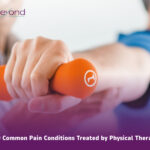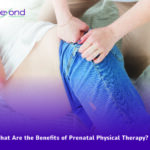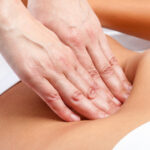Are you looking to heal low back pain relief? Are you suffering from a lower back injury that won’t fully heal? Do you find yourself reaching for an anti-inflammatory, topical cream or ice more often than not… To soothe your back first thing in the morning, or after working a long day?
Low Back pain, is one of the most common reasons someone will seek help from an orthopedic doctor, chiropractor, or physical therapist. And a back injury is one of the most common types of injuries turning into chronic pain. Acute pain, which is temporary and occurs immediately after a specific injury is said to heal within a 6-week period of time. However, if inflammation and pain persist, your body will continue to compensate. Muscles weaken creating imbalances in your body. And your brain and body start communicating differently through your nervous system resulting in chronic pain.
Did you know, in order to heal low back pain, consistent, gentle conservative integrative physical therapy treatment may help? And PT treatments can increase a patient’s ability to reduce heavy prescription pain drug use or prevent surgery. Quality integrative physical therapy and focused exercises can provide positive long term results helping heal low back pain naturally.
Integrative Healing
In this second post of the “Heal Chronic Pain” series, our focus is to “Heal Low Back Pain.” Dr. Carr Integrative Physical Therapy will provide an understanding of the main types of low back pain… How they manifest and how unassuming areas of our body may relate or contribute to this long term discomfort.
As discussed in our “Heal Chronic Pain” blog, acute pain can naturally improve on its own. You will probably notice a decrease in discomfort around 6 weeks after the initial injury. This is the amount of time it takes for the natural healing progression to occur.
However, a more serious chronic condition may result if the right steps aren’t taken. If there is an increase in stress either in our body or from external sources. Whether a re-injury or a new injury occur during the acute phase of healing. It is about providing appropriate guidelines and education on what you may and may not do to assist in the healing process. Understanding what is happening and why, is extremely empowering.
Anatomy of Pain Source
Structurally, there are several anatomical regions of our lower back that can be the source of your pain. You may experience one or a combination of these symptoms. Depending on the source of your pain, treatment will vary and is extremely specific to your injury. If you are getting treatment to heal your chronic low back pain and your symptoms are not improving. That treatment may not be right for you. Getting the proper diagnosis and proper specific treatments for the diagnosis is highly important in your healing process. As an incorrect diagnosis may cause a cascade of treatments that are not helping you.
Disc Inflammation
Do you experience pain with sitting, bending or squatting? You may have a bulging or herniated disc. Discs are most aggravated with sitting, bending and squatting activities. Symptoms improve with standing and walking. Receiving specific treatment to release restrictions in your hip flexors and pelvis can improve symmetry. This can take pressure off of your back and is extremely important for bony, muscular and nerve balance. Specific hands on treatment can address the disc inflammation, irritation and possible nerve compression. In addition, exercises to extend the spine are helpful to reduce and pain and discomfort. This may include bridges to strengthen your buttock muscles, gentle standing backward bends, or prone backward bends.
Joint Degeneration
If you have more pain with standing and walking. You may have narrowing between the vertebra joints where the nerves exit to extend down into your legs. This is a type of arthritis also known as stenosis. The compression forces on the bony structures are most irritated with standing, walking or lying flat on your back or stomach. Unique manual therapy techniques to release restrictions in the abdomen, lower back and pelvis can take pressure off of these areas of your spine. Both are necessary to help reduce pain in your back and down your legs. Sitting and forward bending exercises often alleviate such symptoms. Strengthening your abdominal muscles, buttocks, and upper back muscles can improve stability of your spine while decreasing overall pain.
Unstable ligaments
Do you experience increased back pain with sedentary activity such as standing still, sitting or sleeping? If you have pain at rest, and feel better with activity, you may be experiencing instability in your spine. This can be due to a slipped disc, unstable vertebrae or sacroiliac joint laxity. Movement is best for pain relief. Changing positions every 20-30 minutes, such as standing from sitting or going for a walk, is helpful. You may also benefit from wearing a sacroiliac belt to provide temporary support to stabilize your spine until you regain proper strength in the appropriate areas.
Other Internal Structures That May Be Affecting Your Chronic Low Back Pain
Aside from the musculoskeletal structures protecting our spinal cord. We cannot forget the other very important vital organs and vessels that may contribute to your low back pain. There are suspensory ligaments that connect your abdominal organs to your pelvis and spine. Fascia that wraps and protects our major blood vessels and nerves. As well as each of the digestive and reproductive organs. When a back injury occurs, these ligaments and fascia attachments may adhere to each other when scar tissue or other adhesions form. All of which play a part in restoring your strength, stability and mobility.
Whole Body Physical Therapy To Cure Low Back Pain
Depending on the source of your pain, hands on treatment as well as exercises will vary. Whole body physical therapy not only addresses the pain you have in your back, but other areas that can also affect your pain. Do you have tight hips? Have you had abdominal surgery in the past resulting in scarring such as an appendectomy, cesarean section, hysterectomy, or other abdominal procedure? No matter how old or new the scar tissue, it weaves and impedes on muscles, nerves and arteries. Scar tissue may create deep adhesion in the abdominal muscles, organ structures as well as blood and nerve supply to soft tissues affecting long term healing.
Do you notice eating certain foods affects your back pain? Does your back pain worsen while on your menstrual cycle? Have you experienced digestive bloating, constipation or diarrhea while experiencing back pain? These and many others, play a part in healing low back pain. Although your pain manifests in your lower back, other areas of restriction, dysfunction or stress may contribute to your healing. Keep this in mind when seeking treatment. Keeping the whole body in mind when addressing the root cause, contributing factors and long term healing.
In Closing
If these possible contributing factors are not addressed in your treatments, you may not experience the strong reduction in symptoms that you deserve. Integrative treatment for chronic low back pain must address these contributing factors. Along with appropriate exercise and lifestyle changes. All of which can make a long-term positive impact not only on your back pain but on your overall quality of life. Whole body integrative physical therapy can greatly help you regain control when rehabilitating. At the end of the day, know that you can feel better and sleep better all while restoring confidence in yourself to get back to a safe healthy active lifestyle.
















